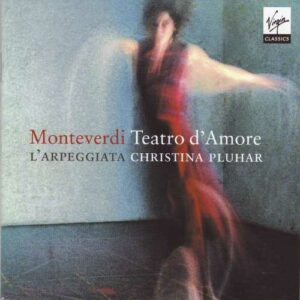Program: #07-06 Air Date: Jan 29, 2006
The towering genius who presides over the entire transition from the Renaissance to the baroque is treated in this concert as the person who most effectively took us from polyphonic madrigals to the dramatic vocal solo with basso continuo, leading us into the next musical era--the ensemble L'Arpeggiata performs.
This program is Free for all, thanks to this generous Preservation Grant:
We continue our long and fruitful association with our partners at Radio Netherlands in presenting a series of concerts from the 2006 Holland Festival of Early Music at Utrecht.
We will also direct listeners to their web site, which will provide more in-depth information about the music and performers we hear as well as more information about the festival (www.rnmusic.nl).
For its 25th anniversary, the entire 2006 Festival was dedicated to the early Italian 17th century.
NOTE: All of the music on this program was performed by the ensemble L'Arpeggiata directed by Christina Pluhar, and is dedicated to the work of Claudio Monteverdi (1567-1643). As the program notes:
Toward the end of the Renaissance, the wish to recreate the art of the Ancient Greeks would dominate artistic creation. In various camerate across Italy, scientists and artists discussed the implications of this new focus, and the poet Rinuccini (whose libretti would be set to music by Monteverdi and Caccini) played a major role. The first operas were created: Daphne by Gagliano and Euridice by Peri, all written in the new style of recitar cantando. The singers easily adopted to this new style of singing, while maintaining their old technique of singing polyphony.
But while most singers worked for the church and therefore had to master two styles of singing, composers started to experiment more and more with ornamentation. Caccini coined the term sprezzatura for the art of tastefully adding notes to the written music to enhance the impact of the text. It would be with his two collections of Le nuove musiche
that solo singing would receive its true genesis. Singers went to great lengths to apply the same agility in their singing voice as in their speaking voice.
But tonight's star, of course, is Claudio Monteverdi. His nine madrigal books offer an incomparable insight into the development of the polyphonic madrigal which would eventually give birth to the dramatic vocal solo with basso continuo. In fact, his search for new ways of expressing text quite closely followed that of colleagues, but his daring use of dissonants and chromatism drew the attention of the Bolognese theoretician Artusi. Artusi's (factually justified) criticism prompted Monteverdi to think through his ideas and come up with a radically new starting point. The era of the first practice (prima prattica) in which music ruled the words was over.
Instead, the need for the words to be heard and understood immediately was the justification for the so-called seconda prattica, which dictated different composing rules. His new conception of the seconda prattica allowed Monteverdi to distance himself slightly from the Florentines, who he suspected were more interested in bel canto singing than a new way of composing. His first opera, L'Orfeo (1607) already had all the elements of a real opera: and expressive role for the orchestra, the use of Leitmotiv, and a balance between voices and instruments, between recitatives and arias, between virtuosity and more serene singing, all according to the musical affect.
At the same time, in his madrigal books Monteverdi explored the dramatic potential of polyphonic writing. In the Sixth Book (1614) he still wrote five part lamenti, but in the Seventh (1619) he broke with this tradition and started composing harmonically complex duets. Everything that was left for Monteverdi to experiment with was contained in this book. This is especially clear if you compare it to the Eighth Book (1638; his Ninth was published after his death in 1651). If the Selva morale e spirituale (1640/1) was Monteverdi's testament to sacred music, then the Eighth Book offers the full range of his secular repertoire.
With the expression of emotion in music as his ultimate goal, Monteverdi went beyond the recitar cantando to the more melodic aria, not the "light version" of his Florentine colleagues, but as a true way of conveying feeling.
All works performed are by Monteverdi:
- Toccata (from L'Orfeo)
- Tempro la cetra (Book VII)
- Possente spirto (from L'Orfeo)
- Sinfonia (from Altri canti d'amor)
- Lamento della Ninfa (Book VIII)
- Damigella, tutta bella (from Scherzi musicali)
- Sinfonia, Ritornello's en moresca (from L'Orfeo)
- Ohime, chio cado (Book IX)
- Interrotte speranze (Book VII)
- Chiome d'oro bel tesoro (Book VII)
- Vago Augeletto (Book VIII)
- Si dolce e'l tormento (Book IX)
- Co che soavita (Book VII)
- Augellin (Book VII)
- Oblivion soave (from L'Incoronazione di Poppea)
- Ballo della ingrata (Book VIII)
- Pur ti miro (from L'Incoronazione di Poppea)
Composer Info
Claudio Monteverdi (1567-1643),
